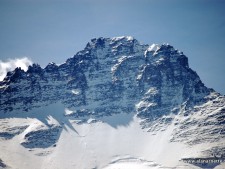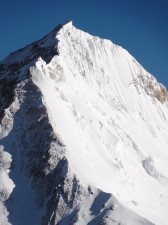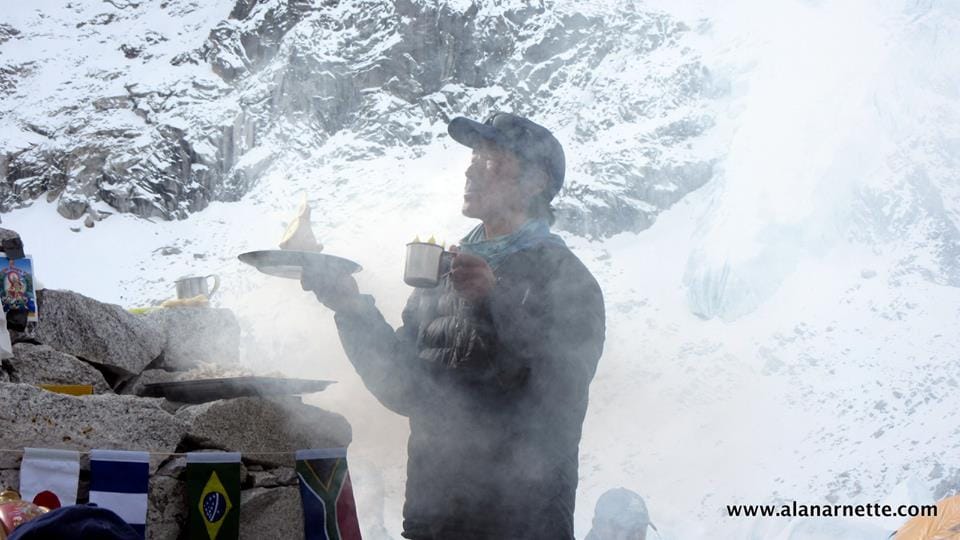
Every Everest climber, mind actual or armchair, recognizes the term “Lhotse Face” as a difficult section leading to the Death Zone at 8, healing 000 meters. What some people often miss is that the Face is part of the 4th highest mountain on Earth, Lhotse standing 27,940 feet or 8516 meters.
Sitting in the fake Starbucks in Lukla after my successful Everest summit, I overheard a middle-aged climber talking to a group of trekkers, ” I just summited Lhotse, it is a lot harder than Everest.” The group began to grill him on the details and he rewarded them with tales of “real” climbing, rock fall and severe altitude without all the crowds and those peak baggers over there on Everest. “I would never climb Everest.”, he sniffed.
I continued to enjoy my excellent latte while reflecting on the most recent addition to my summit list. 🙂

Lhotse is gaining popularity with climbers and commercial guides as an alternative to Everest or as a return to the Khumbu to climb another 8,000m mountain. It is half the cost of an Everest climb but takes about the same amount of time.
To climb Everest, is almost to climb Lhotse; given they share the identical route up to the Geneva Spur, located on the Lhotse Face. However, there is a real difference. As my friend in the Starbucks boasted, Lhotse involves some serious rock with deadly rock fall danger. The final climb to the main summit of Lhotse is through a 500 foot narrow gully that often sheds rocks, large and small.
On my climb, I spent a lot of time with Simon who was climbing Lhotse. We often discussed why he was spending 99% of the same time to snag the “lesser” peak. He was consistent in his answer, I want to do something other’s don’t. That is a common profile of Lhotse climbers. He also was under no illusion that it was easier, or harder, than Everest – it was what it was.
We climbed together and left Camp 3, both on supplemental oxygen, on the Lhotse Face about the same time. I went on to the South Col and Simon turned right, up the very steep face towards Lhotse’s summit and their High Camp. He gave me an update once we both had returned safely to Base Camp.
It was harder than he expected, steep, icy, dangerous. He climbed slowly and carefully and had a great time! Simon was very satisfied with his climb and enjoyed the views of Everest! In fact he took a picture of Everest from the summit of Lhotse that showed me somewhere on my summit bid.

We compared technical difficulty. I felt the snowless Southeast Ridge Slabs were challenging with crampons against rock. He felt the large boulders and sometimes snow-free rock features of the gully were challenging. I felt the altitude and exposure to the fierce east winds were problematic. He felt the summit exposure was unsettling.
He also spoke of his crowds. Going up he was behind a group that accidentally kicked rocks dangerous towards them, not uncommon. With Lhotse’s new fame, it seems the crowd factor is shared between the two mountains We both admired the light from each other’s headlamp going higher on the other peak as we went higher on our own.
So, Lhotse is a great climb right up there with Everest. It is less crowded, requiring a bit more in technical climbing, especially in low snow years. While 1,095 feet lower than Everest, it requires precisely the same preparation, skills, gear and support.
And regardless of which mountain you summit, the same amount of respect is deserved – for both mountain and climber.
Climb On!
Alan
Memories are Everything



12 thoughts on “Lhotse – the Other Everest”
hey Alan,
I’m getting caught up on all your great coverage of Everest. At EBC last year I remember one of our guides asking one of our climbing Sherpas who had climbed both Everest and Lhotse, “Which mountain is harder to climb Everest or Lhotse?”….The Sherpa replied, “Yes”
Ginger, just sent you a bergschrund picture
Alan do you know where I can find a good picture of the bergschrund at the bottom of the Lhotse face? I cant seem to find any pictures of it, but its mentioned several places.
Amazing article.
Have I read before that some have actually “skied” down Lhotse? I can’t imagine with the ice, but nothing surprises me anymore what people can accomplish. Great article, Alan.
Great article Alan, I admire your ability to write so objectively. Which is harder… take your pick. Everest is higher and Lhotse is more technical. IMG has a nice article on their website on this very topic. Either way, both climbs are a tremendous accomplishment. Maybe you’ll be on top of the Big L someday soon 🙂
Alan. Good read. Thanks. If I recall correctly Ed Viesturs had also succeeded in his double summit attempt years back. Herculean effort that. Have to be in peak form. Any recommended reading on Lhotse? Haven’t read much on Lhotse summit attempts.
Alan: Great info. I really like the picture of the Southeast Ridge from Lhotse. Amazing to see the climbers on the summit and making the climb along the ridge.
Really nice to hear about this Alan; thanks for sharing your experiences!
Allan…another great blog…I really felt if you can do the Lhotse face and get to Camp #3 without oxygen on your first rotation that high that you definitely had a shot at the summit…you could use that accomplishment as a positive boost for your summit rotation and “bank” that difficult ascent.
“One day at a time.”
John
🙂
Alan: Great article, as usual. One hears so much about Everest, but the details of its close neighbour are often few and far between. Didn’t I hear somewhere that some expeditions now combine an Evest climb and Lhotse climb. I thought a couple of climbers did both during last year’s climbing season. Assuming one still might have some energy left after an Everest summit (big assumption, I know) and can recover in a couple of days, then you can utilize the acclimatization that you’ve already built up and make an attempt on Lhotse almost immediately — beats having to come back and spend another two months! Have you heard of these “double summit expeditions”?
Thanks Greg, glad you enjoyed the article. Yes there have been double summits. Last year, 2011, Michael Horst, an AAI guide, summited 21 hours after summitting Everest. He summitted Everest via the normal South Col route, returned to the South Col and on the normal route back to Camp 3 turned left up the Lhotse Face and tagged Lhotse proper. Note, he is a guide! Many people think about doing this but few do it so props to Michael!
Comments are closed.